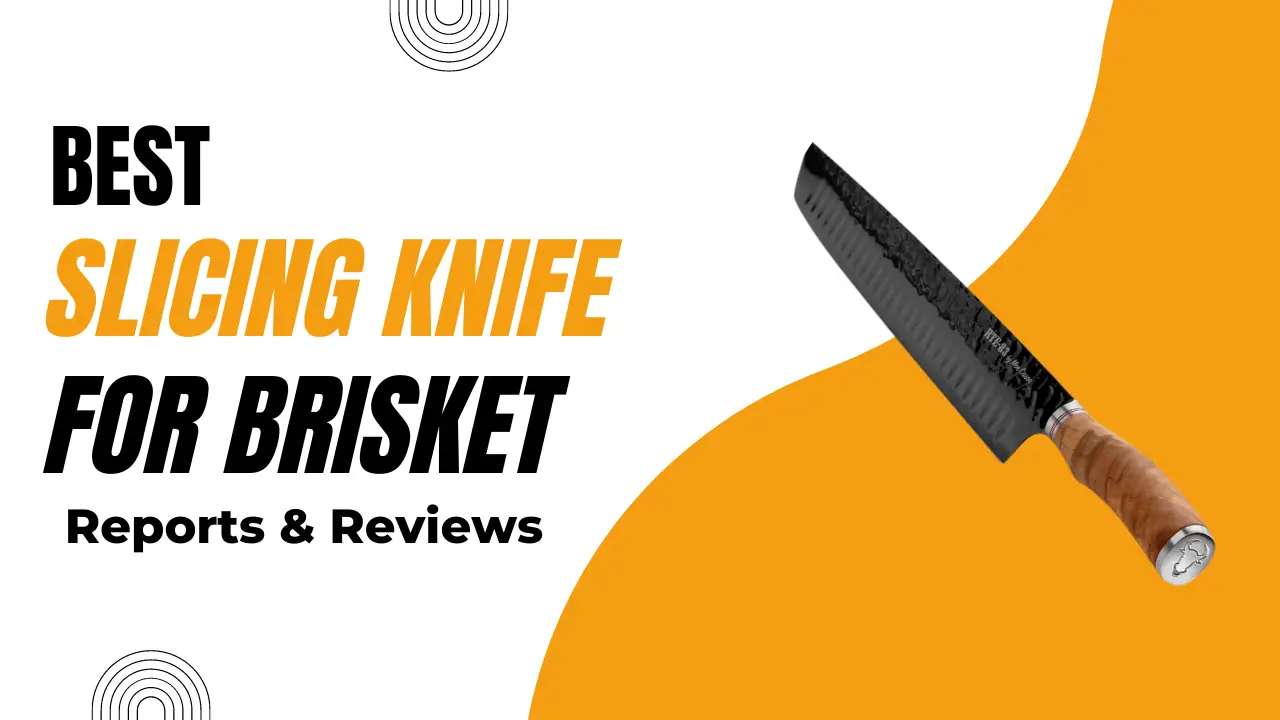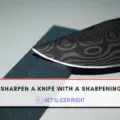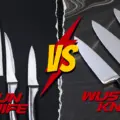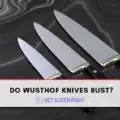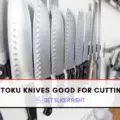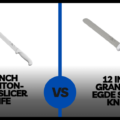Carving knives are essential in any kitchen or workshop, helping create beautiful and intricate designs on materials like wood or meat. However, over time, these knives can become dull and less efficient. Carving knives are usually sharpened with a whetstone, honing rod, and sandpaper.
Why Sharpening A Carving Knife Is Important?
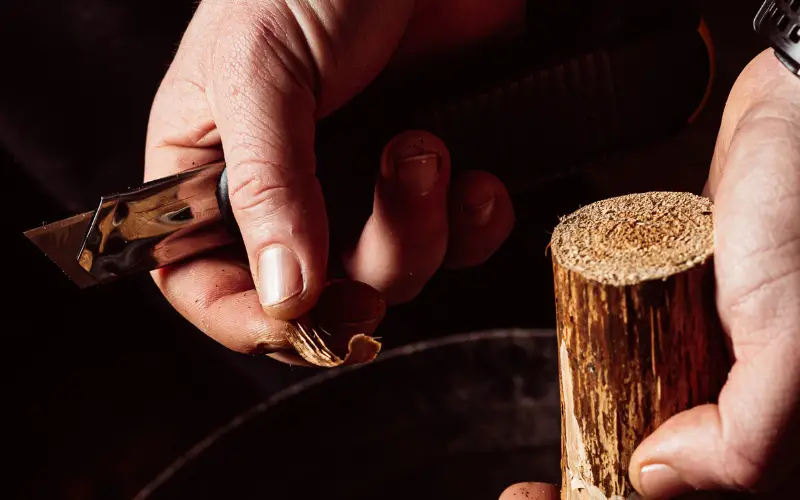
A sharp carving knife is crucial for ensuring smooth and precise cuts. Dull knives can lead to rough and uneven surfaces, making your work less accurate and visually appealing. Moreover, dull knives require more cutting force, increasing the risk of accidents and injuries.
Types Of Carving Knives
There are three main types of carving knives, each with its unique characteristics and sharpening requirements:
- Straight-edged knives – These knives have a straight, thin blade, perfect for making clean and precise cuts.
- Serrated knives – Their toothed edges are excellent for cutting through tough materials without tearing or crushing.
- Curved knives – Featuring a curved blade, these knives allow for controlled cuts and intricate carving work.
Methods Of Sharpening A Carving Knife
There are several methods available to sharpen your carving knives, including:
- Whetstones – Traditional sharpening stones come in various grits for different sharpening stages.
- Honing Rods – Also known as sharpening steels, these rods help maintain a knife’s edge between sharpening sessions.
- Electric Sharpeners – Motorized devices that sharpen knives quickly and efficiently.
- Manual Sharpeners – Handheld devices with pre-set angles and abrasive materials to sharpen knives.
How To Sharpen A Straight-Edged Carving Knife?
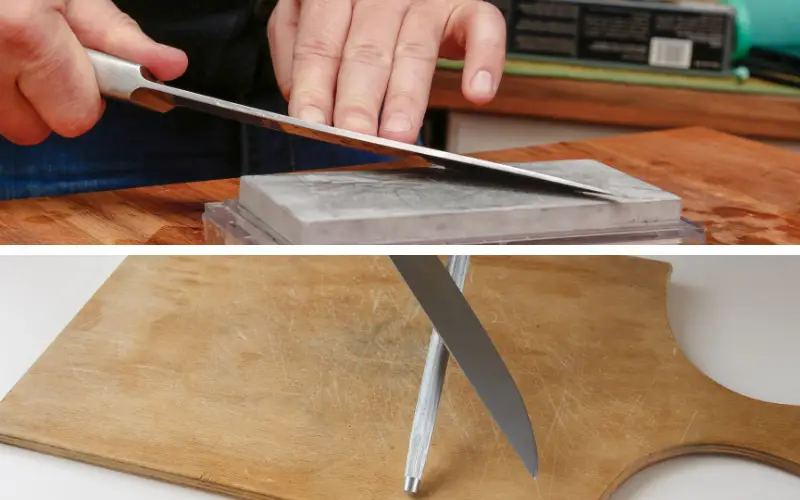
Sharpening a straight-edged carving knife requires a two-step process: using a whetstone and a honing rod.
Using A Whetstone
Step 1: Choose the appropriate grit: Start with a coarser grit (400-800) for dull knives and finer grit (1000-3000) for sharpness.
Step 2: Soak the whetstone: Submerge the stone in water for 10-15 minutes before use.
Step 3: Find the right angle: Hold the knife a 20-degree against the whetstone.
Step 4: Sharpen one side: Glide the knife across the stone, applying even pressure while maintaining the angle. Repeat this process 10-15 times or until the edge is sharp.
Step 5: Switch sides: Flip the knife over and repeat the process on the other side.
Step 6: Fine-tune the edge: Use a finer grit whetstone to polish the blade and remove any burrs.
Using A Honing Rod
Step 1: Hold the rod vertically: Secure the honing rod in one hand and the knife in the other.
Step2: Find the correct angle: Hold the knife a 20-degree against the rod.
Step 3: Sharpen the edge: Swipe the blade down the rod while maintaining the angle, alternating sides after each swipe. Repeat this process 5-10 times.
How To Sharpen A Serrated Carving Knife?
Sharpening a serrated knife requires a special technique and tool, such as a tapered sharpening rod or a serrated knife sharpener.
Step 1: Choose the appropriate tool: Match the diameter of the sharpening rod to the serrations on your knife.
Step 2: Sharpen each serration: Insert the rod into each serration and apply gentle pressure while moving the rod back and forth.
Step 3: Repeat the process: Continue sharpening each serration until the blade is sharp.
How To Sharpen A Curved Carving Knife?
Curved knives, like gouges or hook knives, require a slightly different approach for sharpening.
Step 1: Select the right sharpening tool: Choose a slip stone or a curved sharpening stone that matches the curve of your knife.
Step 2: Find the correct angle: Hold the knife a 20-degree against the stone.
Step 3: Sharpen the blade: Glide the knife along the stone, applying even pressure and maintaining the angle. Repeat this process until the edge is sharp.
Why Do Carving Knives Have Holes?
Carving knives are designed with holes for two reasons.
- The holes reduce drag by allowing air to move around the blade during use. This helps make cutting more efficient and creates cleaner cuts.
- Another reason is that they can be used in a honing jig, making sharpening easier and more precise than freehand. The honing jig is a clamp that holds the knife in place and lets you sharpen it evenly.
- It also helps keep your fingers away from the blade for safety. You should use a honing jig if you have one, but it is unnecessary for sharpening your carving knife.
How To Sharpen A Carving Knife With Sandpaper?
Step 1: Choose the appropriate grit: Begin with a coarse grit (around 400) and progress to a finer grit (approximately 1000-2000) for an impeccable finish.
Step 2: Secure a flat surface: Fasten the abrasive sheet onto a wooden block, glass panel, or rigid plane, employing adhesive or clamps.
Step 3: Grasp the knife: Clench the handle firmly, positioning your fingers away from the cutting edge.
Step 4: Establish the bevel angle: Identify the existing angle, typically 10 to 20 degrees, and maintain it consistently throughout the sharpening process.
Step 5: Commence honing: Glide the blade across the sandpaper, applying consistent pressure while ensuring the bevel remains flush against the abrasive surface. Execute a sweeping motion to encompass the entire blade.
Step 6: Alternate sides: After several strokes on one side, switch to the other, maintaining an equal number of passes for uniform sharpness.
Step 7: Progress to finer grits: Transition from coarser to finer grits, repeating steps 5 and 6 for each abrasive gradation. This refines the edge and eradicates any lingering scratches.
Step 8: Inspect and test: Examine the blade for evenness and sharpness, and perform a cutting test on paper or other suitable material.
How To Sharpen Carving Knives With Dimond Plate?
Step 1. Secure the diamond plate to a stable surface or use a handheld sharpener.
Step 2. Place the blade at an angle of 15-30 degrees on the plate with the cutting edge facing forward and down, away from your body.
Step 3. Hold it in place and begin moving it back and forth, pushing forward and pulling back.
Step 4. Rotate the knife at a slight angle while pushing it across the diamond plate for a finer finish to the sharpening process.
Step 5. Repeat steps two through four several times on each side, and then check the blade with your thumb or forefinger to determine if it is sufficiently sharp.
Step 6. If not, repeat the process until you achieve the desired sharpness.
Step 7. When finished sharpening, clean and dry the blade with a cloth before safely storing it. This will help prevent rusting or damage to the knife’s edge over time.
Maintaining Your Carving Knife
To keep your carving knife in top condition, it’s essential to practice regular maintenance:
- Regular Honing – Use a honing rod to maintain the knife’s edge between sharpening sessions.
- Proper Cleaning and Storage – Clean your knife after each use and store it in a knife block or protective sheath to prevent damage.
Safety Tips For Sharpening A Carving Knife
- Always sharpen your knife on a stable surface to prevent slipping.
- Wear cut-resistant gloves for added protection.
- Keep your fingers away from the blade while sharpening.
- Do not apply excessive pressure while sharpening; let the tool do the work.
FAQs
What angle do You sharpen a carving knife?
When sharpening a carving knife, you should aim to maintain the original angle of the blade. Depending on the type of knife and its purpose, this angle can vary from 8-20 degrees. If your knife is brand new or has not been used for some time, use an angle guide to determine what angle it was designed for before beginning the sharpening process. Use an angle of 12-15 degrees for a general-purpose carving knife.
What is the difference between honing and sharpening?
Sharpening removes material from the blade to create a new edge, while honing aligns and straightens the edge without removing material.
Is a carving knife flexible?
No, a carving knife is meant to be very sharp and stiff. It should not bend when light pressure is applied. If the blade is flexible, it has probably lost its edge and needs to be re-sharpened.
How thick should a carving knife be?
A good carving knife should have a blade between 0.013 mm thick. A thicker blade will be more durable, heavier, and less maneuverable. On the other hand, a thinner blade will be sharper, more flexible, and quicker to sharpen, but it may dent or chip easier with repeated use.
What is the best material for a carving knife?
Carving knives come in various materials, the most popular being stainless and high-carbon steel. Stainless steel is great for its durability and rust resistance but won’t hold an edge like high-carbon steel. High-carbon steels are usually found on higher-quality models, as they are more durable and long-lasting. Carbon steel can be difficult to sharpen, but it’s worth the effort as the edge will stay sharp longer than a stainless steel blade. In addition, some blades are made of ceramic or titanium.
Conclusion
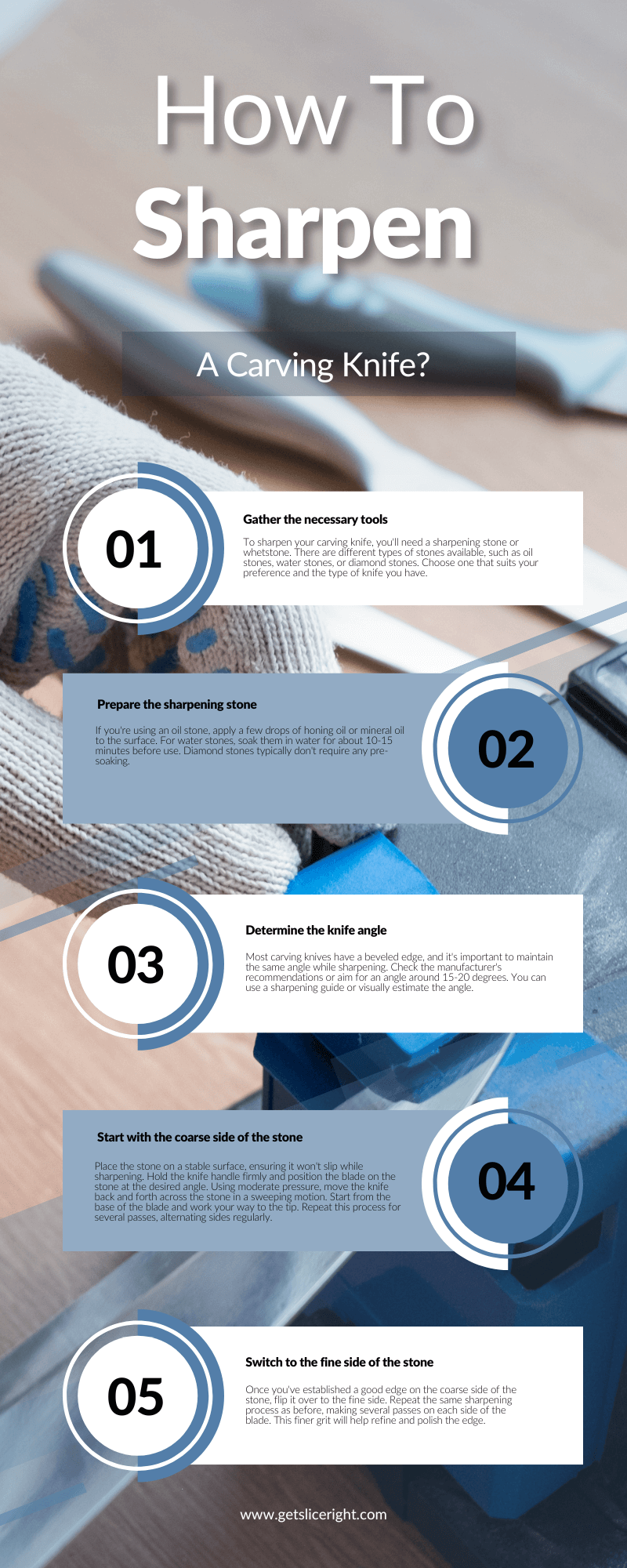
Sharpening your carving knife is crucial for maintaining its performance and ensuring precise, clean cuts. Using the appropriate sharpening tools and techniques for your specific type of knife, you can keep your carving knives in excellent condition and enjoy safer, more efficient work. Don’t forget to practice proper maintenance and safety measures to prolong the life of your knives and protect yourself during the sharpening process.

John Hebdon is a food enthusiast, passionate chef, and author of various articles and blog posts related to food and cooking. With a deep love for all things culinary, John’s blog serves as a platform to share his extensive kitchen experiences with a broader audience.
In addition to his culinary expertise, John has a flair for writing and a natural ability to share his passion for food with others. His articles and blog posts are informative, engaging, and packed with practical tips for readers of all skill levels.
As a food enthusiast and writer, John is always on the lookout for new and exciting culinary experiences. Whether it’s trying out a new restaurant, experimenting with a new recipe, or simply sharing a favorite dish with friends and family, John is always eager to explore and share the world of food with others.

